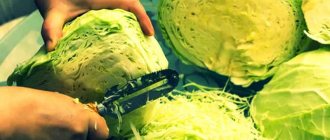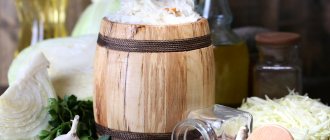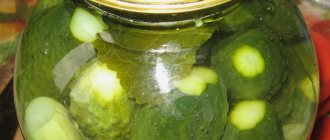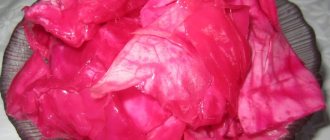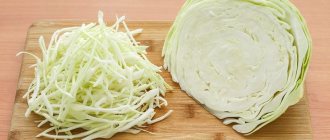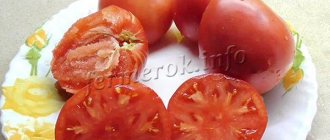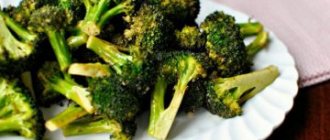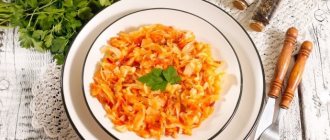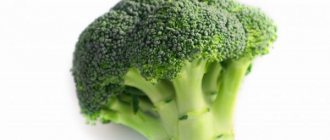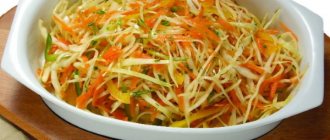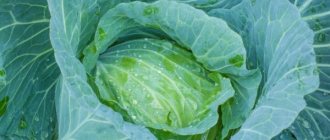Preparing healthy vegetable inflorescences for the winter is an excellent option for those who are tired of standard canned cucumbers and tomatoes. You will get very crispy, juicy and delicious snacks. At the same time, salting cauliflower is not difficult at all.
Preparing healthy vegetable inflorescences for the winter is an excellent option for those who are tired of standard canned cucumbers and tomatoes.
A simple pickling recipe
The secret of the recipe is in the brine. When cooked correctly, the center is soft but crispy, and the snack looks beautiful in a jar with carrots. You can also add broccoli there.
The recipe is perfect for those whose children do not like to eat this vegetable boiled or steamed..
Components:
- Cauliflower – 3 kg.
- Carrots - half a kilogram.
- Water – 1 liter.
- Salt - two tablespoons.
- Black peppercorns.
- Grape and black currant leaves (to taste, optional to add).
- Celery.
- Dill.
Cooking steps:
- Wash the cabbage thoroughly and separate into inflorescences.
- Peel the carrots, rinse, cut into slices.
- Place grape and currant leaves at the bottom of the jars.
- Place carrots, cabbage, and celery in jars one by one. Place greens and leftover carrots on top.
- Pour brine over everything and tighten.
If you wish, you can reduce the list to water, salt and cabbage.
Step-by-step instructions for pickling vegetables at home
Why salt cauliflower for the winter?
This is useful. Salted cauliflower, like a number of other vegetables, is a component of many diets, as it contains a minimal amount of sugar, fat and calories. This is a real storehouse of fiber required for the normal functioning of the digestive system. Also, salted cauliflower contains elements that fight free radicals, so-called antioxidants. Dill and garlic, often part of the brine, regulate the number of bacteria. Cauliflower, which occupies one of the places of honor among other healing vegetables, is very easy to prepare. How to salt cauliflower?
First you need to choose the right vegetable, the signs of which are:
- white or cream color (yellow color indicates an overripe product);
- density of cabbage head;
- no stains;
- freshness of the outer leaves of the fork;
- absence of black dots indicating the use of large amounts of chemicals in cultivation.
Like many other types of vegetables, cauliflower is an essential product for most people who adhere to a healthy diet. It contains a minimal amount of fat, calories and sugar. This vegetable is also considered a real storehouse of fiber, folic acid, vitamins B, C, E, K, PP, iron, calcium, sodium, proteins, phosphorus, magnesium and iodine.
Daily use of the product:
increases immunity;
- normalizes the functioning of the digestive system;
- strengthens the walls of blood vessels;
- calms the nervous system;
- reduces the risk of malignant neoplasms and stroke;
- helps reduce cholesterol levels in the body.
Cauliflower rarely causes allergies. 100 g of salted cabbage contains 28.4 kcal, of which:
- 2.5 g proteins;
- 0.3 g fat;
- 4.2 g carbohydrates;
- 2.1 g dietary fiber;
- 0.1 g organic acids;
- 90 g of water.
How to properly pickle cauliflower? Pickles will certainly turn out delicious if you choose cabbage only with light green inflorescences, without spots or damage. It is also recommended to place the vegetable in a weak salt solution for 3 hours before cooking to eliminate insects. Glass, wooden or enamel containers (without chips) that do not oxidize are perfect for pickling for the winter.
For the classic version of salting you will need:
- 3 kg of fresh cabbage;
- 0.5 kg carrots;
- ¼ tbsp. coarse salts;
- 1 liter of clean water;
- tarragon, bay leaves, dill, celery leaves - to taste.
Preparation:
- Initially, the cabbage is disassembled into inflorescences, which should be immersed in boiling water for 1-2 minutes so that they become a little softer.
- Carrots are cut into small cubes or circles.
- Mix the specified amount of water with salt, bring to a boil and stir until the crystals are completely dissolved.
- While the brine is cooling, you need to sterilize the jars and put bay leaves with tarragon on their bottom.
- Next, the containers should be filled with cabbage mixed with carrots, and the rest of the greens should be placed on top, pour brine over everything and close the lids tightly.
- The pickling must be kept in a warm place for 1.5 months, and then placed in a cool room.
In Korean
A spicy snack with a piquant aroma is prepared quite simply:
- Boil 1 grated or cut into strips carrots (in salted water) for 30 minutes;
- mix it in a separate container with fresh inflorescences;
- add to the vegetables 3 allspice peas, 3 chopped garlic cloves and 1 tsp. red pepper;
- fill everything with hot brine from 1 liter of water, 3 tbsp. l. salt, ¼ tbsp. vinegar and 3 drops of lemon juice;
- close the lid and let it brew.
Tip: before serving, it is recommended to season the salad with vegetable oil.
By combining different types of seasonal vegetables, you can end up with an interesting and colorful dish. Let's look at how to cook cauliflower with beets and carrots.
For salting you will need:
- water – 1.5 l;
- salt and sugar - 100 g each;
- 2 kg cabbage;
- carrots and beets – 1 piece each;
- garlic – 3 cloves;
- allspice and black peppercorns – 3-6 pcs.
Preparation:
- Cabbage inflorescences are mixed with pre-grated carrots and beets, pepper, and chopped garlic.
- Then the mass is packed tightly into jars and filled with hot marinade made from water, salt and sugar.
- Containers with cabbage are not covered with lids and must stand at room temperature for at least 4 days, after which it can be put in the refrigerator.
With vinegar
This recipe for quick-cooking salted cauliflower helps you get a fragrant and tasty dish from the following ingredients:
- 300 g apple cider vinegar;
- 10 peas of allspice;
- 1-2 heads of cabbage;
- 20 g salt;
- 450 ml water;
- 100 g sugar;
- Bay leaf.
Preparation:
- The cabbage, disassembled into inflorescences, is boiled in boiling water for 1-2 minutes.
- After which you need to drain it in a colander to get rid of excess liquid, and sprinkle with 0.5 tbsp. l. salt, let stand.
- Place 1 bay leaf at the bottom of the jars and fill the containers with salted inflorescences.
- Pour hot vegetable broth with added sugar, salt and vinegar over everything, cover with lids and roll up.
With celery
You can quickly and tasty cook cabbage with celery root. This dish will turn out not only appetizing, but also healthy. You will need:
- salt – 30 g;
- water – 1 l;
- celery root – 1 piece;
- cauliflower – 1 kg.
We suggest you read: How and where to properly store pumpkin
Preparation:
- Boil finely chopped celery and cabbage inflorescences for 5 minutes in salted water (until half cooked).
- Strain and immediately place in clean sterile jars and seal with iron lids.
- Containers with preservation should stand upside down for 1-2 days, after which they are placed in a dark, cool room.
Quick preparation for the winter in jars
This is the simplest recipe, accessible even to inexperienced cooks.
Components:
- Water.
- Cabbage.
- Celery.
- Salt.
The simplest recipe, accessible even to inexperienced cooks
. Preparation steps:
- After washing the cabbage and dividing it into individual inflorescences, you should immerse it in cold, lightly salted water for half an hour. This way it will be saturated with moisture and soften a little.
- Boil the soaked inflorescences until fully cooked, or best of all, steam them in a slow cooker or double boiler. It will be very fast and useful.
- Cut the celery and carrots into medium-sized pieces. They can be cooked together with the main character of the dish or boiled separately.
- Sterilize the jars. Arrange the vegetables one at a time in layers.
- You can add the same water in which the vegetables were boiled. This way you will achieve maximum preservation of their usefulness, and also achieve a special concentrated taste with which the cabbage will be imbued.
How to pickle milk mushrooms for the winter: simple recipes and methods
The secret of this recipe lies in the fact that the vegetables are pre-cooked. Don't be afraid that they will become too soft in the jar and taste bad.
In this recipe, the vegetables are not crispy, but soft, but soaked in brine. The recipe is so simple and quick that the cabbage will be ready in half an hour.
How to Blanch Cauliflower
Blanching is a special method in which a vegetable is first boiled or steamed and then quickly cooled. It is used to destroy all harmful organisms and prepare the most cleaned and healthy cabbage for freezing or further rolling into jars.
Blanching is used to prepare cabbage for canning.
Blanching steps:
- Rinse the vegetable thoroughly. This will not only ensure cleanliness of contaminants, but will also help remove all accumulated pesticides. Rub it with your hands under running water for extra cleansing.
- Cut into florets. They shouldn't be too big.
- Prepare a large pot of water. To get crispy pickles, you should use 4 liters of water for every half a kilogram of cabbage. The water should boil strongly, only after that add the vegetable to the water.
- Prepare the next pan for another blanching step: cooling. Immediately after boiling, cauliflower should be placed in water with ice. The water temperature should be no higher than 16 degrees.
- If you want to blanch cabbage for subsequent freezing, it is better not to add salt at the cooking stage. This way the vegetables will quickly boil, and after defrosting they will taste unpleasant, with a salty aftertaste. If you decide to salt the cabbage, do it before you throw the vegetables into the water.
- Before sending the boiled cabbage to the second pan, you should turn off the stove, cover it with a lid and leave for a few minutes to allow the cabbage to “cook”. There is no point in boiling the cabbage until it is fully cooked so that it is ready to eat right away. It should be soft on the outside and hard on the inside.
- After a couple of minutes, remove the cabbage from the pan and place in cold water with ice.
- When the vegetables have cooled, you can take them out. Drying is a mandatory step. Without this, pieces of ice will remain on the cabbage after freezing, and its taste will be lost.
- Once dry, place the cabbage in an airtight container and freeze. If you plan to roll it into jars, then you no longer need to freeze the cabbage; you can roll it up right away.
Beijing cabbage: 5 step-by-step recipes for preserving it for the winter
If you don't have ice to add to the water during the cooling phase, prepare a separate pot of water ahead of time and place it in the refrigerator while the cabbage cooks.
The blanching method, although time consuming, is very simple. This way you preserve all the vitamins and prepare the cabbage for subsequent use.
Armenian appetizer
The appetizer according to this recipe turns out to be piquant thanks to garlic and very aromatic, not to mention the delicious taste.
Components:
- Cauliflower - 2 kg.
- Carrots - 1 kg.
- Dried celery – 20 grams or 1 package.
- Garlic – to taste, up to 4 heads.
- Bay leaf - 10 leaves.
- Peppercorns.
- Table salt - a couple of tablespoons.
- Water - 6 l.
The appetizer according to this recipe turns out to be piquant thanks to garlic
. Preparation steps:
- Cut the washed vegetables into pieces, and divide the cabbage into inflorescences.
- First boil the water along with seasonings, garlic and salt. You shouldn’t immediately throw vegetables into boiled water; it’s better to wait until they cool. When it has cooled to 40 degrees Celsius, place the vegetables in jars and pour in the marinade so that the water lightly covers them.
- Seal the jars, cover with a heavy weight and let sit for 5 days to a week. After this, send it to a cold place - a refrigerator, a cellar or a glassed-in balcony.
Vitamin preparation with celery
A recipe with celery is the best option for preserving vitamins for the winter. The recipe is also very simple - brine and vegetables.
Pickles: a wide variety of recipes for the winter
Components:
- Cauliflower – 1 kg.
- Celery – 1 pc.
- For brine: 30 grams of salt per liter of water.
You can also add broccoli to the preparation
. Preparation steps:
- Wash and peel the vegetables. Dry them.
- Cut the celery into small pieces, preferably thin slices.
- Divide the main vegetable into inflorescences. Don't make them too small. After all, the cabbage will boil quickly.
- Soak the prepared vegetables in cool water for half an hour. Then dry and put in jars.
- Put the water on the fire, when it starts to boil, add salt - 30 grams of salt per liter of water.
- Boil vegetables for 5 minutes.
- Remove from heat. Vegetables can be immediately placed in jars. Banks must be sterilized.
- Further storage of this preservation occurs in a dark and cool place. Turn the jars upside down and leave them like that for a couple of days.
The recipe for pickling with celery is not only tasty, but also very healthy. When salting, all vitamins are preserved, albeit in lower concentrations.
And with tomato it tastes better
Another recipe for salting cauliflower at home is pickling using tomato juice as a marinade. The easiest and fastest way to cook it is with only one cabbage, without adding other vegetables, but if desired, add dill, dry or fresh. Tomato juice is taken according to the amount of vegetable.
Boil the juice, adding a little black pepper and bay leaf (add salt if necessary), dill (if dry). We divide the cabbage into smaller inflorescences, soak them so that insects float to the surface, and wash them to remove all debris. Place in sterilized jars along with dill (if fresh) and fill with boiling tomato juice. Roll up and store in a cool place.
Hi all. Today's episode is dedicated to cauliflower. We will pickle it in 1 and 3 liter jars, and also learn how to make it in a hurry. And right now, a selection of recipes for pickled cauliflower for the winter, as well as a quick recipe, awaits you.
Did you know? This cabbage has much more beneficial properties than any other.
Cauliflower is ordinary cabbage with a higher education (Mark Twain)
Its main property is that it is easily absorbed by the body. In addition, cauliflower contains very, very much vitamin C and B, and also contains vitamins A, E, D, K, H, U. You can find carbohydrates, fiber, organic and polyunsaturated acids, starch, and sugar in it. There are also mineral salts of potassium, calcium, chlorine, phosphorus, magnesium, sulfur, sodium, copper, manganese, iron, zinc, molybdenum, and cobalt.
As you can see, the composition of inorganic substances is quite rich.
Cauliflower can be used not only in salads, but also in pickles. Below are some interesting recipes for making delicious pickled cauliflower.
Cooking recommendations
Although cauliflower is not capricious, there are some nuances to its preparation:
- It is better to soak the vegetable in advance so that it becomes a little softer and juicier.
- It is not necessary to boil the inflorescences, it all depends on the recipe. If cooking is required, the cabbage should only be cooked briefly until slightly soft.
- Vegetables can only be preserved in pre-sterilized jars;
- The jars are stored upside down, with the lid down, in a dark place (preferably cool). After two or three days, they need to be turned back over and left for another couple of days.
Preservation recipes can be very diverse, and each of them will be an excellent addition to the main dish in the winter. You can prepare several of the presented options at once - to try for your family. It’s not a shame to put cauliflower from a jar on a holiday table, and there are a lot of vitamins in such an appetizer.
Share:
About the unique properties of the product
Cauliflower, so called because the inflorescences resemble flowers, is characterized not only by its excellent taste, but also by its unique composition with a high content of vitamins C, PP, A, B, phosphorus, protein, calcium, sodium, magnesium and iron.
Dietary fiber from vegetables has a positive effect on the intestinal microflora, protects the gastrointestinal tract from tumors and ulcers by suppressing the activity of harmful microorganisms. Due to its allicin content, consumption of this crop reduces the likelihood of cardiovascular diseases. Cauliflower, which helps reduce the amount of cholesterol in the body, is a low-calorie product: only 30 kcal per 100 g of product. It goes well with all products except melon, watermelon and milk.
